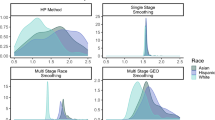Abstract
This paper is a comparison of two contrasting methods for projecting population at the regional and state levels. A projection of the U.S. Bureau of the Census employs standard demographic methods, while the population projection by Data Resources, Inc., is based on economic opportunity. The methodological differences between these two projections are discussed, and the projections for the year 2000 are compared. While both projections use the same national control total for population in the year 2000, some of the regional and state projections are very different. The U.S. Bureau of the Census projects population decline in the Northeast and rapid growth in the West while Data Resources, Inc., projects some population growth in the Northeast and less rapid growth in the West.
Similar content being viewed by others
References
Data Resources, Inc.,Regional Information Service Memoranda, Cambridge, MA: DRI, 1984.
Data Resources, Inc., Regional Information Service, unpublished spring 1984 projections, Cambridge, MA: DRI, 1984.
Eckstein, O.,The DRI Model of the U.S. Economy, New York: McGraw-Hill, 1983.
McDonald, J. F., and D. W. South, unpublished information, Argonne, IL: Argonne National Laboratory, 1984.
Milne, W., and C. Loxley,The WEFA Multiregional Model Project: The Nine Region Census Model, Philadelphia: Wharton EFFA, Inc., 1980.
U.S. Bureau of the Census, Current Population Reports, Series P-25, No. 922,Projections of the Population of the United States. 1982–2050 (Advance Report), Washington, D.C.: U. S. Government Printing Office, 1982.
U.S. Bureau of the Census, Current Population Reports, Series P-25, No. 937,Provisional Projections of the Population of States, by Age and Sex: 1980 to 2000, Washington, D.C.: U.S. Government Printing Office, 1983.
U.S. Bureau of the Census, Current Population Reports, Series P-25, No. 952,Projections of the Population of the United States, by Age, Sex and Race: 1983 to 2080, Washington, D.C.: U.S. Government Printing Office, 1984.
Author information
Authors and Affiliations
Additional information
Funding for this project was provided by the U.S. Department of Energy under Contract W-31-109-Eng-38.
The authors hope that this paper has illustrated the extent to which such a change in the growth pattern established in the 1970s may matter to the regions and states.
Rights and permissions
About this article
Cite this article
McDonald, J.F., South, D.W. A comparison of two methods to project regional and state populations for the U.S.. Ann Reg Sci 19, 40–53 (1985). https://doi.org/10.1007/BF01294830
Received:
Revised:
Issue Date:
DOI: https://doi.org/10.1007/BF01294830




